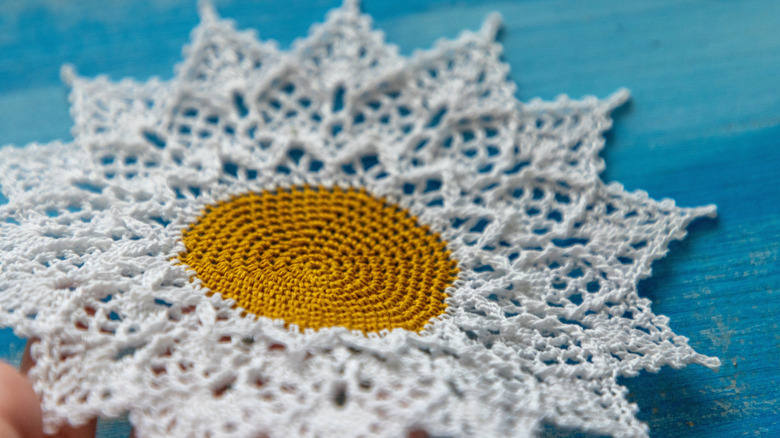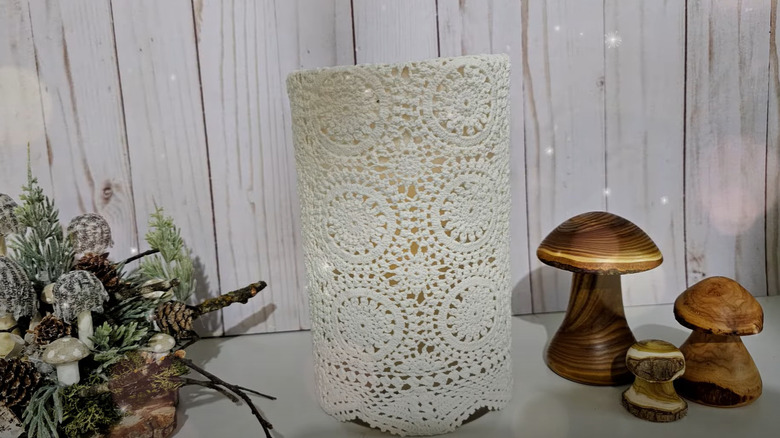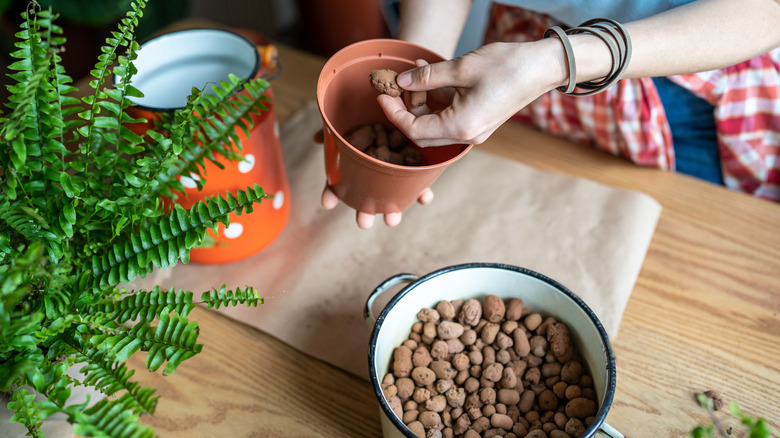Grab Some Vintage Doilies From The Thrift To Give Basic Planters A Stunning Upgrade
The delicate and intricate doilies you come across at the thrift store can find new life in your home — and not just underneath a plate. There are lots of creative ways to repurpose vintage doilies around the house to upcycle the lace-like material that was commonly placed on furniture in the mid to late 1800s. Made of cotton or linen, they were essentially used as lace-like coasters and placed under dishware, like plates or bowls. Most doilies have a circular shape, but there are some that come in square, oval, or as a table runner, and they all contain different types intricate patterns.
You can thrift vintage doilies to transform the space behind your bed or use them to add a decorative touch to a plain old vase or planter for real or fake plants. For the latter project, all you'll need is a container for your plants, the doily (or doilies) you want to upcycle, crochet thread, and a needle. While you're at your favorite thrift store looking for doilies, you can also keep an eye out for a vase or planter to use for this project. You'll be covering the container with the doilies, so this will make it easier to determine whether you have enough fabric when you leave the store with your finds. Before you get started, you should also make sure that you have a long enough string to stitch or glue the length of the material together.
How to upgrade and customize basic planters with vintage doilies
After choosing your doily — one or multiple — at the thrift store, you'll need to decide if you're satisfied with the fabric's natural color or if you want to dye it another hue. Once you figure that out and make that coloring happen, you'll need to attach the doily to the vase, which you can do by gluing it in place or sewing it on with a needle and crochet thread. Simply wrap it around the container and stitch the edges together. Any excess at the top will need to be folded inside and glued in place.
If you're using several smaller doilies, you could sew them together. However, it would be easier to glue them directly onto your container. If you opt for this route, you could also paint or decoupage the surface first.
You don't have to stop there, though. You can adorn the lace with paint, beads, or ribbons. Once you've decorated your container just how you want, you can use it to hold a bouquet, grow some flowers from seed, or display your faux florals. And if this craft doesn't suit your style, there are lots of stunning DIY planter ideas out there.
Potential pitfalls for DIY planters with vintage doilies
All DIY projects have things to look out for, and this one is no exception. At the thrift store, make sure to closely inspect the doilies you decide to buy for any stains or browning spots. Because they're made of older fabric, they will likely show aging signs, so you'll need to decide if an antique look is what you want. If not, you can try to get the stains out. If you opt for the latter, combine hot water and a gentle detergent in a container, then submerge the doily in it for a few minutes. Next, rinse it out and let it dry in the sun. Check to see if the stain or discoloration is gone. If not, repeat the process as many times as necessary, but if the brown spots don't come out at all, you can always dye the doily or doilies another color to hide them.
The plants themselves can create certain pitfalls, whether you use this DIY planter with the real or fake variety. With real plants, you'll need to make sure the new pot has a drainage hole, or put a highly absorbent material or clay on the bottom of the container. This will help keep the plant's roots healthy. You can also put a smaller planter with a drainage hole inside the vase.
If you choose to place artificial plants in your new planter, using a green foam block to keep them in place might not be your best option. If your doily, vase, or both are see-through, the block might be fully visible from the outside. Instead, you can let the artificial flowers sit naturally or use a clear plastic stem holder to keep them upright.


